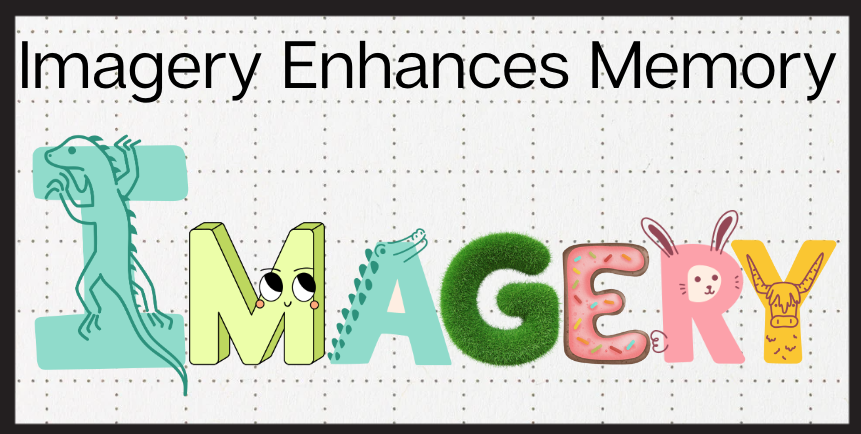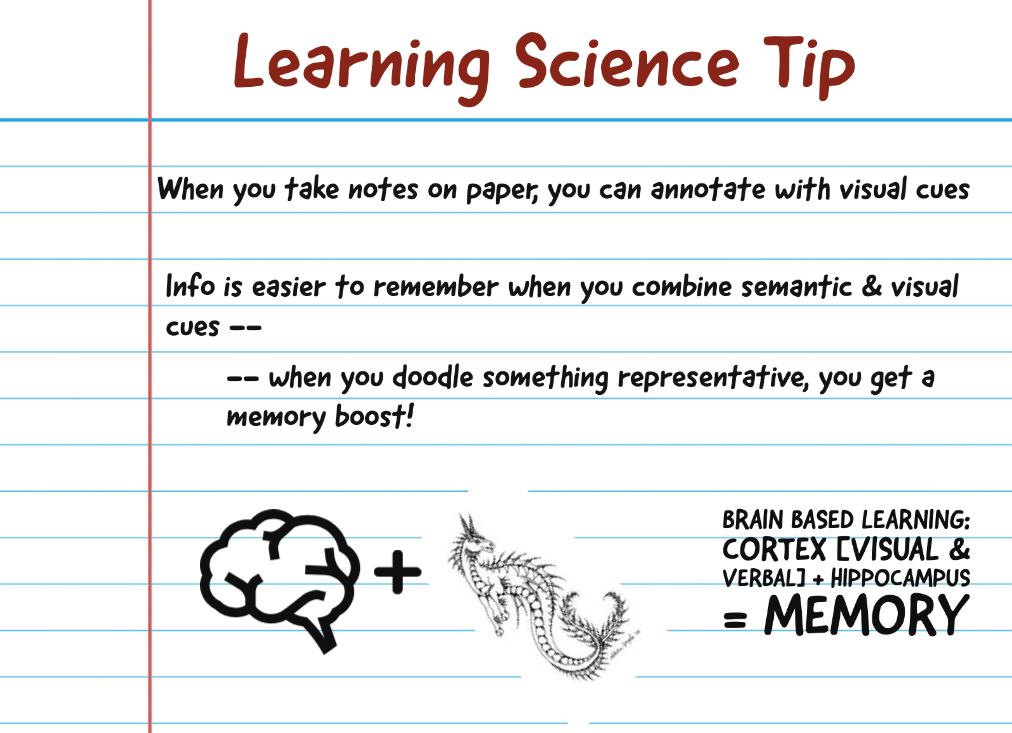Setting the Stage: Imagery is a power memory tool
Nearly every time, without fail, it happens. When it gets out that I am a Cognitive Psychologist with a specialization in memory processes, I know which way the conversation will go: “You study memory? You should study me! My memory is terrible”, followed by a request: “What can I do, to improve my memory? Can you help me?”
Turns out, I can help. I’ll help you all right now. Here’s a solid pro-tip: use imagery!
Images are powerful: our brains love them. Our brains are wired to combine sensory-perceptual-motor inputs into meaningful units that will help us make smart predictions for wise action. Said another way: what makes our brains most happy is when sound, vision, movement, and meaning (semantics) are connected together.
- Sound: Scuttle on the hardwood; bark, bark!
- Vision: small animal, four legs, fur, wagging tail
- Movement: wagging tail, moving paws, jumping and circling
- Meaning: My dog is happy to see me!
I conveyed this scenario to you in words and if you know dogs, you can translate the symbols on the screen to an image in your mind, perhaps even complete with reminiscent sounds and smells and even emotions. If you were to wear a brain scan device while reading these words, I could predict with certainty where your brain would light up (it would be in many places) as you think about interacting with your happy-to-see-fur-baby: your visual cortex, your auditory cortex, your motor cortex, the olfactory bulb, and much more. In the business, we say that memories like these are contained in the brain via “distributed representations,” such that neurons in multiple areas of the brain contain the various bits and pieces of a memory. When we activate a memory, all those neurons that represent all the bits and pieces start firing together, one after another, in a reverberating circuit. In this way, memories are constructed on an as-needed basis.
Really, it’s the potential for a memory that’s stored. Your experiences of remembering happen in the moment, as needed. In order to activate a memory, you need a match with cues: something from then (a sight, sound, smell, word, or emotion) needs to be cued now. A handy feature of this kind of storage and activation process – where parts of a memory are scattered all over the cortex – is that all it takes is one activation cue to get the whole network fired up.
- You hear a sound? Sound activates imagery, movement, and smell.
- See a picture of a dog? Images activate sound, movement, and smell.
- Smell “wet fur”? Smell activates images, sound, movement, and smell.
I hope you get the picture. In this system, the PICTURE [re: imagery in real time or imagined] is a powerful piece of the memory process and images are powerful memory cues. When you need to learn “content” whether that’s a list of vocabulary words or competing theories for a single idea, or just a shopping list, pairing meaningful images to the words will super-charge your memory process.
This principle has a long-standing research history behind it, from an accumulation of work spanning the 20th and 21st centuries. In a field where known-facts often change as research programs progress, such reliability is a rare gem. You really can’t go wrong with blending semantics and imagery. You can sketch the images, embellish your notes with digital images, or even create clever memes to capture key points!
Why isn’t this Pro-Tip [imagery boosts memory] more widely known?
In my experience, this pro-tip is not widely known, despite its near-impeccable empirical legacy. When I discuss this and other principles that come from Learning Science with my undergraduate students, the vast majority have “Why I am just learning this now?!?” moments. Why? I expect there are many reasons, but one I am certain plays a role is our population’s steadfast belief the pseudoscientific Learning Styles perspective.
Not only is there no valid scientific evidence that the notion is correct, it is also at complete odds with what we know to be true about the neuroscience of memory processes. While individual differences in cognitive prowess and control do exist, the Learning Styles framework is not one of them. Following from the discussion above re: distributed representation and the power of visualization, when you limit how you engage with to-be-remembered information you hurt your chances of success.
Limit to one style, limit learning. As it turns out, we are all visual, auditory, and kinesthetic learners. When you can do all three at once, in a connected and meaningful way, your memory system is most productive.
Even though you didn’t know, you did, actually know?
Once you take a moment to think about this, I expect you are starting to realize that you actually knew this already. Our digital world is full of imagery and images stick! We love our memes, Tik-Toks & Reels, and infographics. We don’t want to read plain text anymore – we want pictures to help us understand. We want data visualized, and relationships networked into timelines and webs with accompanying symbols and icons and emojiis. Pictures are truly worth 1000 words. We seek out images, share images, laugh and cry at images. We spend thousands of dollars on glasses and contact lenses to enhance our vision. Vision – that is visualization — is really and truly powerful.
We underutilize this knowledge – even when we are in the know!
Psychology needs an image update.
By “we” in the sentence above I mean Psychology. Way back in 2012 eminent Psychologist Scot Lilienfeld wrote that as a discipline we have failed to adequately manage our reputation and disciplinary knowledge with the general public. This remains true today. The full scope and modern scientific knowledge is not well represented across the media landscape. Especially the visual media landscape.
A google images search for “Psychology Memes” generates an array of meme-template faces interspersed with the same old array of 19th & 20th century figures: Watson, Pavlov, Freud, and Phineas Gage. I am a huge fan of a good Psychology pun, meme, or joke, but this isn’t a good look for us when this is all there is. I know I can find more when I work on refining my search criteria, but folks, it is a hard slog to find visually appealing and funny memes that capture modern, 21st century Psychology content. If it’s hard for me (I’m pretty good at it), then I know others who are not as committed as I am, are unlikely to look much further. So to many, the face of psychology is firmly rooted in the past.

When I change the search query to “Show me Psychology” – putting a different spin on it, what do I find? An array that is much more colorful, but the results are not great otherwise. I see cartoon renditions of Freud, “Psychology facts” that are, in fact, incorrect, disproven theories and a lot of stock photos of faux counseling sessions.

As with the meme-search, this is not a good look for us, either! A quick skim of these google results tells the wrong story about modern Psychological Science. Freud’s ideas are Victorian – that is, Old! Outdated! More often than not, incorrect! He is not the face of modern Psychological Science and he should not get so much digital face-time. The face of Psychology should represent the faces of modern Psychologists.
To take this one step further, when I ask DALL-E to “show me Psychology” the yield is visual nonsense.

It turns out that ChatGPT can generate a decent verbal recitation of what Psychology is all about. You can click the link to see ChatGPT’s response when I asked “What does Psychology Look like”? While OpenAI’s knowledge base does get some things right, when it comes to visualization, even the AIs struggle.
Does Visual Representation of Psychology Matter? Y E S.
I see the lack of visual representation of modern Psychological Science as both a problem and a real lost opportunity. The problem of course is that the current visual landscape in the media is rife with misinformation. It’s going to take a lot more than my Psych students’ efforts to populate the visual media space with clever and up-to-date memes and infographics. The opportunity here is a great one, too. With concentrated and wide-spread efforts at Picturing Modern Psychological Science and spreading this imagery in the digital media marketplace, we can make good on our Science and the long-standing charge to “Give Psychology Away”. Our modern science is informative, far reaching, and fascinating. We can use the media to inform, entertain, and make good on what our science has to offer.
To this end, I am starting up the Picturing Psychology Project. I am making imagery to replace – or perhaps supplement and expand? – the ubiquitous Pillars of Psychology. Pictured here is a poster featuring some of my favorites, so far.

And I am making memes that use the tried and true templates to convey Psychological content that is often, otherwise, challenging to digest. This poster of some recent Cognitive Psychology memes is pretty cool, too, don’t you think? It’s also both fun AND informative!

To join in on the cause here are some things you can do along with me and my students:
- Follow, like and share @psychcoundbites content on Instagram
- Visit @psychsoundbites on Redbubble and get some stickers, posters, or buttons! Hang the posters on your office door, in your dorm rooms, or give them away as gifts (along with some stickers and buttons!). Decorate your computers and water-bottles with stickers. Brighten up your jackets and backpacks with buttons!
- Make your own modern psych-science memes (that is, no more Watson, Pavlov, & Freud memes. There is so much more interesting stuff to picture!)
- Once you make your memes share them! You could even DM them to @psychsoundbites and I may share them too.
- Challenge others to do the same.
We can use our science to improve our science AND to help others improve their lives too. All it takes is a little vision.



